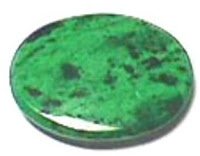As far as nature is concerned there is only one answer to the question,
GOLD COLORED.

Gold nugget from Alaska
There is no such thing as white gold or rose gold in nature, or any other shade of gold, it is all the same color, gold. For some reason in today's market there is an extremely high demand for 'white gold'. Many people believe this is a natural option. The true demand for this white color comes from two other metals, Platinum and Silver. The cost of Silver is still somewhat low, but it will need cleaning as it will tarnish over time. Platinum on the other hand will not tarnish, but the cost is even more than gold.
 White gold was created to be able to sell people a white metal that does not tarnish at a lower price than platinum. This was a keen marketing idea as people would pay the same or even more for it than traditional gold, while the cost of this alloy was far lower than normal gold alloys, thus boosting profits. However, this idea came with a number of problems. To become white, the gold had to be alloyed with a large amount of a base metal, specifically nickel. Many people are allergic to nickel when it is placed against their skin. To further complicate matters, the white color from a nickel gold alloy is not really pretty, as it is more accurately described as 'gray gold', thus the marketing plan was doomed to failure. So this marketing idea of 'white gold' had two problems to overcome, people were allergic to it and it was ugly. So to overcome these problems in order to sell 'white gold' they came up with the idea to plate it with rhodium, one of the members of the platinum family. Rhodium is an extremely expensive metal, far higher than plain platinum, but plating uses such a tiny amount, that the cost is negligible. It is a very strong metal and is very chemically resistant. A thin plating of rhodium over the unappealing white gold makes it look fabulous, so many people now select 'white gold' as the color of choice in their gold jewelry. A considerable amount of market trickery was employed and continues to this today. However, it is all in ones eye, and what the public likes is what the public will get.
White gold was created to be able to sell people a white metal that does not tarnish at a lower price than platinum. This was a keen marketing idea as people would pay the same or even more for it than traditional gold, while the cost of this alloy was far lower than normal gold alloys, thus boosting profits. However, this idea came with a number of problems. To become white, the gold had to be alloyed with a large amount of a base metal, specifically nickel. Many people are allergic to nickel when it is placed against their skin. To further complicate matters, the white color from a nickel gold alloy is not really pretty, as it is more accurately described as 'gray gold', thus the marketing plan was doomed to failure. So this marketing idea of 'white gold' had two problems to overcome, people were allergic to it and it was ugly. So to overcome these problems in order to sell 'white gold' they came up with the idea to plate it with rhodium, one of the members of the platinum family. Rhodium is an extremely expensive metal, far higher than plain platinum, but plating uses such a tiny amount, that the cost is negligible. It is a very strong metal and is very chemically resistant. A thin plating of rhodium over the unappealing white gold makes it look fabulous, so many people now select 'white gold' as the color of choice in their gold jewelry. A considerable amount of market trickery was employed and continues to this today. However, it is all in ones eye, and what the public likes is what the public will get.
Ironically, the same rhodium plating over silver keeps the silver from tarnishing. It looks and wears exactly like the finished rhodium plated nickel/white gold jewelry at a small fraction of the cost. It also has another advantage, silver is much less likely to create an allergic reaction as the nickel/white gold when some of the plating wears off, plus the silver looks whiter and prettier than the nickel/white gold when the plating wears off.
And plating does wear off, regardless of what it is, so any plated jewelry needs to be returned to the jeweler periodically for a new 'dip'. Often they will do this for 'free' or just a small cost as many times customers will make a new purchase when they take the item in to be replated. This is a win-win situation for the jeweler, as it requires very little skill to plate something once you are set up to do it.
For some unknown reason, more people in Europe have a problem with the allergic reaction to the nickel in the white gold. So another metal, palladium, which is a precious metal, which people are not allergic to was added to the gold. The cost is much higher than nickel and is even much higher than the traditional gold alloys, but there is much less allergic reactions with palladium compared to nickel, but the old problem remains that the color is just too gray. The finished project has little eye appeal as it is not as white as even inexpensive silver, thus the same solution is again employed, a rhodium dip.
Can you see the difference in plated jewelry versus non-plated by your eye? Most people can spot it very easily. All our lives we have seen cheap costume jewelry plated with gold, silver and rhodium and many people automatically think 'cheap' when they see that plated look. But nothing can compare and have the elegant look than a highly polished piece of precious metal, which plating can never hope to duplicate. Plus plating cannot, or really should say, should not be polished, as it will simply wear off, so once it is plated, it is 'done'.

So now we have our "rose gold" buffs. Rose gold is also called pink gold or red gold. This is simply a gold alloy with a lot more copper and less silver. Copper is the lower grade of the metals used in traditional alloys. When it percentage is increased, it causes the gold to have a redder color, but it can also give more people an allergic reaction and may tarnish a little as well. It is very pretty alloy all by itself, so it requires no plating.

Ever hear of green gold? It is more of a light yellow as it contains only two metals, gold and silver. In 18k it is great to work with as a smith and a purist in the trade, but the paler color is not very popular.

The color of the gold most people are used to seeing today in the United States is really 58.5% gold with the remainder split between silver and copper. This is called 14k yellow gold. The color can be improved by adding more copper and less silver, but this also makes it more brittle, more likely to tarnish, turning green when worn by some people, and a bit more difficult to work with. Usually the remaining 41.5% of 14k gold is split evenly between silver and copper, thus producing a rather washed out gold color.
People generally trend towards the traditional 18k gold alloys as the color is more golden than the 14k. Traditional 18k gold is 75% gold with the remaining 25% being half silver and half copper. At a recent Gem Show, a gold dealer was showing the various grades and colors of gold, all in all he had 66 different shades.

Some goldsmiths make jewelry that uses almost pure gold such as 23k which contains over 90% gold and a small amount of silver. It is a very rich golden color and is often thought of as too soft by most American standards. The most common carats used for gold in bullion, coins, jewelry making and goldsmithing are:
999 (24 karat) (millesimal fineness 999)
916 (22 karat) (millesimal fineness 916)
833 (20 karat) (millesimal fineness 833)
750 (18 karat) (millesimal fineness 750)
625 (15 karat) (millesimal fineness 625)
585 (14 karat) (millesimal fineness 585)
417 (10 karat) (millesimal fineness 417)
375 ( 9 karat) (millesimal fineness 375)
The use of the carat (karat in North American spelling) is a system of denoting the purity of gold by fractions of 24. The carat (karat) term is only associated with gold, millesimal fineness is used for all other precious metals. The United States currently issues 22k and 24k gold coin.


United States 22k Gold American Eagle and 24k Gold Buffalo coins
In the jewelry business, I believe that it has become necessary that full disclosure of what is being bought is made, whether it be about gemstone treatments, natural or man made gemstones, metal treatments, or what the grade the metal being used is. It is simple honesty at it's best. Many people, especially at markets and craft shows have been misled about the gold, the silver and the gemstones being purchased. That is disturbing trend. Educated customers are happy customers. They will come back and buy more, because they know what they are getting, andthey are making a fully educated choice.

 Some of the colors within the Leapordskin Jasper arfe repeated along the sides with Poppy Jasper peanut beads, peach Crystals and gunmetal seed beads.
Some of the colors within the Leapordskin Jasper arfe repeated along the sides with Poppy Jasper peanut beads, peach Crystals and gunmetal seed beads. The silver plated French Hook earrings hang 1 1/2 inch with Crystals and Poppy Jasper.
The silver plated French Hook earrings hang 1 1/2 inch with Crystals and Poppy Jasper.


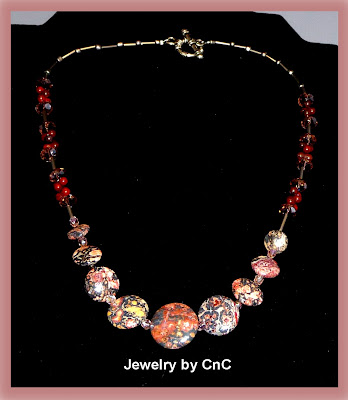


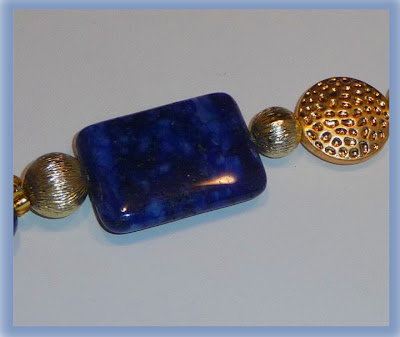









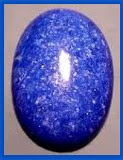








 The 19 inch neckace is finished with a silver plated heart Toggle clasp.
The 19 inch neckace is finished with a silver plated heart Toggle clasp.
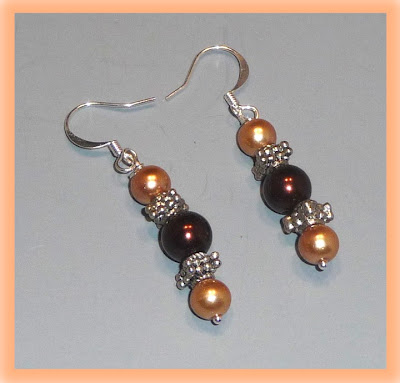



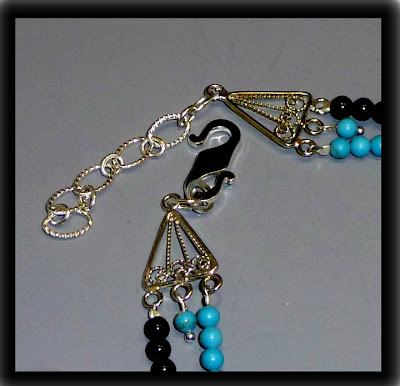










 Using an assymetrical design and earthtones, this 3-strand necklace uses large Picture Jasper coin beads as focal points between bronze toned wire bird-cage beads and Czech Crystals for one side. Czech glass brown and white tear drops and Citrine chips complete the opposide side of the necklace. Ceramic rondels and Citrine chips complete the back of the necklace with a golden S-hook clasp along one side that dramatizes the unusual arrangement of the different shapes and sizes of the components used in this 24 inch necklace.
Using an assymetrical design and earthtones, this 3-strand necklace uses large Picture Jasper coin beads as focal points between bronze toned wire bird-cage beads and Czech Crystals for one side. Czech glass brown and white tear drops and Citrine chips complete the opposide side of the necklace. Ceramic rondels and Citrine chips complete the back of the necklace with a golden S-hook clasp along one side that dramatizes the unusual arrangement of the different shapes and sizes of the components used in this 24 inch necklace.




